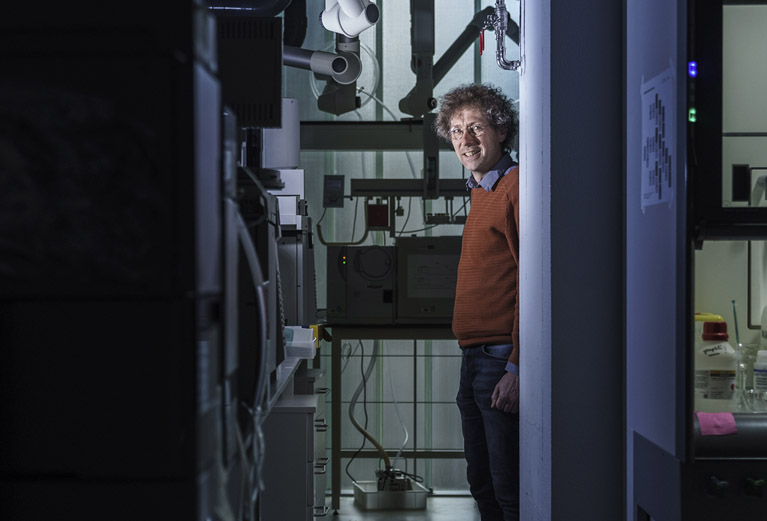
ThebreakthroughAdri Minnaard
The elusive molecule
There were times when Adri Minnaard was on the verge of despair. For instance, when his colleague in Wageningen, Teris van Beek, told him that he had once again failed to replicate the molecule he was looking for -a signalling chemical that wasps use to find each other. But now, after nearly thirteen years of research, he’s almost got it.
The substance the organic chemist is trying to replicate comes from the ichneumon wasp and could be very useful. Organic farmers sometimes use wasps to protect their crops instead of chemical pesticides. It would be nice to be able to monitor how many wasps are flying around once they’ve been released. The insects usually don’t get bigger than half a millimetre, which means they’re difficult to keep track of.
The chemicals they emit might just help. Wasps tend to have poor vision, so they secrete pheromones to let their potential mates know where they are. Anyone able to figure out the structure of these pheromones would be able to build equipment that detect the chemical in greenhouses, which would aid in monitoring the number of wasps present.
Shared project
Even though it’s his expertise, Minnaard wasn’t confident that he would succeed when he started his study back in 2011. Because the insect is so small, the amounts of pheromones it secretes are equally minuscule. ‘We’re talking picograms: a millionth of a millionth of a gram’, says Minnaard. ‘Unless you know what you’re looking for, amounts like that are practically impossible to detect using our current equipment.’
Without money, you can stay curious
Because of this, it didn’t become a paid research project for, for instance, a PhD student to finish in a few years. The pressure to get results would have been too high, says Minnaard. ‘You can’t get your PhD if it might take you ten years to get there. Besides, without money, you can stay curious.’
The project became a shared project: nearly twenty different researchers, mostly master students and PhDs, worked on it for short periods of time. Sometimes, no one would be working on it for a while, says Minnaard. ‘And no two people ever worked on it simultaneously.’
Mirror image
There were many bumps in the road. At one time, the technician who was really good at distinguishing between male and female wasps under the microscope retired. This was an important task, because only female wasps produce the hormone that Minnaard was trying to replicate. As such, someone else had to spend a lot of time to learn how to tell the two sexes apart.
Mirrored molecules can have entirely different characteristics
Minnaard and his researchers nearly had it in 2014. There were only two options left: two nearly identical molecules. ‘They were like each other’s mirror image’, says Minnaard. ‘That may not sound that significant, but mirrored molecules can have entirely different characteristics.’
But when Minnaard sent one of these molecules to his colleague in Wageningen, he was told it wasn’t the correct one. Turns out he needed the other mirror image.
Ultimate test
While it was an easy fix, this meant the research wasn’t finished yet. Minnaard already knew that the pheromone consisted not of one, but of two different molecules; it’s a mixture. But in spite of the structure resembling the first molecule so closely, it took him another nine years to actually produce it.
There is just one more ultimate test to do. In Wageningen, Van Beek will release the pheromone near the wasps to see if they respond to it, says Minnaard. ‘Administering the replicated pheromone to the wasps should affect the males. That would mean we made the right chemical.’
If the males respond, Minnaard will be able to publish his definitive results in 2024, thirteen years after the start of the project. But if someone were to knock on his door tomorrow to ask him to replicate another pheromone, he wouldn’t hesitate for a second.